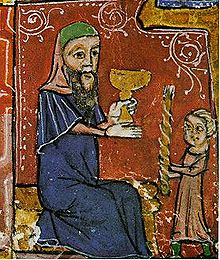Hawdala candle

The hawdala candle is a Jewish ritual object. It is used for the ceremonial departure of the Shabbat ( Hawdala ).
In ancient times, as is common in the Mediterranean, Jews used oil lamps for lighting. The Mishnah According to a normal oil lamp (נֵר ner ) in the Havdalah ceremony used. However, Rawa, a fourth-century rabbinical authority, recommended a torch (אֲבוּקָה avuḳah ) because it would give more light. It was evidently a torch common in antiquity. But centuries later, this advice provided a starting point for the development of the hawdala candle.
Only in the prayer book of Saadja Gaon (10th century) is the possibility of using a wax candle for the hawdala ceremony instead of the oil lamp . Meanwhile, candles had become more and more common in the Christian liturgy. In the 13th century, the wealthy Kalonymos family in Worms used a wax candle for hawdala and called it avuḳah . With its fragrance and its large flame, it was certainly suitable for a religious ritual, but as a luxury item it was not affordable for many Jewish families.
From the 13th to the 15th century, lights were used in Christian worship that were twisted together from several (sometimes differently colored) individual candles. Contemporary Jewish households also used such candles, for example the family of Israel Isserlein from Wiener Neustadt (d. 1460), a halachic authority of the Habsburg Empire. His student Joslein ben Moses used the German term winding candles to describe his rabbi's hawdala candle. Various authors of the 14th century (Menachem Meiri, Aaron ben Jakob haKohen, Nissim von Gerona) seem to have such twisted candles in mind, but they do not describe them in detail. They only go into the fact that the hawdala candle should have red, greenish and white flames, since the plural "lights" is used in the blessing over the candle.
A cheaper alternative was to attach an ordinary wax candle to the tip of a torch-like holder. According to Jewish illustrations of the late 15th and early 16th centuries, this appears to have been common practice. There are also Christian examples of this type of lighting, so that one can speak of a common material culture.
In the 16th century, the multi-wick, twisted candles went out of fashion in the majority culture, while Ashkenazi Jews clung to them. From then on, candles of this type were Jewish ritual objects. In Sephardic Judaism they were unusual. Josef Karo therefore does not mention the hawdala candles in his standard work Schulchan Aruch . Moses Isserles from Krakow added in his commentary on the Shulchan Aruch that an avuḳah for the hawdala ceremony has two wicks.
However, wax candles were still a luxury. Rabbi Jonathan Eybeschütz , who died in 1764 and worked in Metz , Prague and the three parishes of Hamburg , Wandsbek and Altona , found a solution for poorer parishioners. He recommended dipping thin strands of flax or cotton in sebum and tying them together to make a hawdala candle. In the middle of the 19th century, cheap, industrially manufactured candles came on the market, so that hawdala candles were now easily available. There are two types of candles: in France, Germany and Austria-Hungary the candles were braided like a braid, whereas in Poland they were twisted tightly together in a spiral. The latter corresponds better to the late medieval type.
Web links
literature
- Michele Klein: The Candle of Distinction: A Cultural Biography of the Havdalah Light . Brill, Online Publication, 2014. ( PDF )

